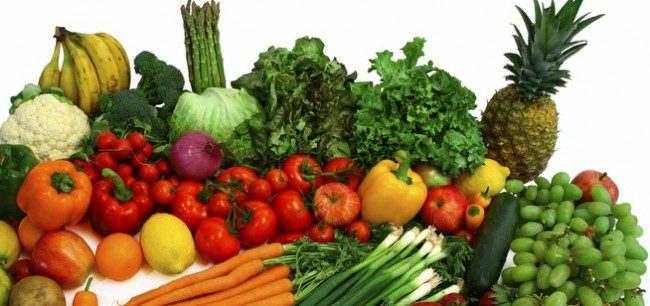Oriental Medical Therapies – Tricia Miller L.Ac.
217 N 5th Ave #203 Wilmington, NC 28401 (910) 431-3836
Vegetarian Diets for Children: Right from the Start

Eating habits are set in early childhood. Choosing a vegetarian diet can give your child—and your whole family—the opportunity to learn to enjoy a variety of wonderful, nutritious foods.
Children raised on fruits, vegetables, whole grains, and legumes grow up to be slimmer and healthier and even live longer than their meat-eating friends. It is much easier to build a nutritious diet from plant foods than from animal products, which contain saturated fat, cholesterol, and other substances that growing children can do without. As for essential nutrients, plant foods are the preferred source because they provide sufficient energy and protein packaged with other health-promoting nutrients such as fiber, antioxidant vitamins, minerals, and phytochemicals.
Vegetarian diets provide excellent nutrition for all stages of childhood, from birth through adolescence. Of course, an infant’s nutritional needs are best met by his or her mother’s breast milk. It’s nature’s way of boosting the baby’s immunity as well as his or her psychological well-being.
Doctors recommend introducing solid foods in the middle of the first year of life. The best weaning foods are soft plant foods such as ground, cooked cereals, mashed fruits, and well- cooked vegetables. Given a chance, toddlers and young children usually enjoy a wide variety fruits, vegetables, grains, and legumes—even more so if they are involved in the preparation. School-aged children are often curious about where their food comes from and delight in learning how to cook, visiting farmers’ markets, and gardening. Adolescents raised on a vegetarian diet often find they have an easy time maintaining a healthy weight and have fewer problems with acne, allergies, and gastrointestinal problems than their meat-eating peers.
Some studies suggest that the growth of vegetarian children is more gradual than that of non-vegetarians—in other words, vegetarian children grow a bit more slowly at first, but they catch up later on. Final heights and weights for vegetarian children are comparable to those of meat-eating children. Interestingly, breast-fed babies also grow more slowly than bottle-fed babies. Somewhat less rapid growth during the early years is thought to decrease disease risk later in life.
On the other hand, diets rich in animal protein, found in meat, eggs, and dairy products, appear to reduce the age of puberty, as shown in a 2000 study from the Harvard School of Public Health, which found that girls who consumed higher levels of animal protein compared to vegetable protein between 3 and 8 years of age went through menarche earlier. Nature may well have designed the human body to grow up more gradually, to reach puberty later, and to last longer than most people raised on omnivorous diets experience.
In a 1980 study in Boston, researchers measured the IQs of vegetarian children. Some of the children were following a macrobiotic diet, a few were Seventh-day Adventists (many of whom follow a plant-based diet), and the rest were from families that had simply decided to go vegetarian. On intelligence testing, the kids were considerably above average, with a mean IQ of 116. Now, the diet may have had nothing to do with their intelligence. Rather, these vegetarian families were better educated than the average meat-eating family, and it is probably the parental education, rather than a dietary effect, that was reflected in their children’s measured intelligence. However, this study should reassure vegetarian parents who wonder whether animal products contain something necessary for brain development. Clearly, they do not.
Perhaps the most important consideration for feeding children is this: Lifelong dietary habits are established at a young age. Children who acquire a taste for chicken nuggets, roast beef, and French fries today are the cancer patients, heart patients, and diabetes patients of tomorrow. Children who are raised on whole grains, vegetables, fruits, and legumes will have a lower risk of heart disease, stroke, diabetes, cancer, and many obesity-related illnesses compared to their counterparts raised on the average American diet. Because of this, they will also tend to live years longer.
The complex carbohydrates found in whole grains, beans, and vegetables provide the ideal energy to fuel a child’s busy life. Cultivating a taste for brown rice, whole wheat breads and pastas, rolled oats, and corn, as well as the less
common grains barley, quinoa, millet, and others, will boost the fiber and nutrient content of a child’s diet. In addition, steering children away from sweets, sugary drinks, highly processed baked products, and overly sweet cereals will help them avoid overeating and gaining unwanted weight.
Naturally, children need protein to grow, but they do not need high-protein, animal-based foods. Many people are unaware that a varied menu of grains, beans, vegetables, and fruits supplies plenty of protein. The “protein deficiencies” that our parents worried about in impoverished countries were the result of starvation or diets restricted to very few food items. Protein deficiency is extremely unlikely on a diet drawn from a variety of plant foods.
Very young children may need a slightly higher fat intake than adults do. Healthier fat sources include soybean products, avocados, and nut butters. Soy “hot dogs,” peanut butter and jelly sandwiches, seasoned veggie burgers, and avocado chunks in salads, for example, are very well accepted. However, the need for fat in the diet should not be taken too far. American children often have fatty streaks in the arteries—the beginnings of heart disease—before they finish high school. In contrast, Japanese children traditionally grew up on diets much lower in fat and subsequently had fewer problems with diabetes, heart disease, obesity, and other chronic diseases.
Parents will want to make sure their child’s diet includes a regular source of vitamin B12, which is needed for healthy blood and nerve function. Deficiencies are rare, but when they happen, they can be a bit hard to detect. Vitamin B12 is plentiful in many commercial cereals, fortified soy and rice milks, and nutritional yeast. Check the labels for the words cyanocobalamin or B12. Children who do not eat these supplemented products should take a B12 supplement of 3 or more micrograms per day. Common children’s vitamins contain more than enough B12. Spirulina and seaweed are not reliable sources of vitamin B12.
The body also requires vitamin D, which children and parents are happy to know can be obtained by simply playing outdoors in the sun. Fifteen to twenty minutes of daily sunlight on the hands and face is enough sun exposure for the body’s skin cells to produce the necessary vitamin D. Children in latitudes with diminished sunlight may need the vitamin D found in multivitamin supplements or fortified non-dairy milks.
For calcium, beans, dried figs, sweet potatoes, and green vegetables, including collards, kale, broccoli, mustard greens, and Swiss chard, are excellent sources. Fortified soymilk and rice milk and calcium-fortified juices provide a great deal of calcium as well. In addition, eating lots of fruits and vegetables, excluding animal proteins, and limiting salt intake all help the body retain calcium.
Growing children also need iron found in a variety of beans and green, leafy vegetables. The vitamin C in vegetables and fruits enhances iron absorption, especially when eaten together with an iron-rich food. One example is an iron-rich bean burrito eaten with vitamin C-rich tomato salsa. Few people are aware that cow’s milk is very low in iron and can induce a mild, chronic blood loss in the digestive tract, which can reduce iron and cause an increased risk of anemia.
Again, the best food for newborns is breast milk. When breast-feeding is not possible, commercial soy formulas are nutritionally adequate. There is no need for infants to be raised on cow’s milk formulas. In addition to containing colic- inducing proteins that bother many children, cow’s milk is a common cause of allergies. Unfortunately, immune responses to milk proteins are implicated in insulin-dependent diabetes and even in Sudden Infant Death Syndrome. Soy formulas are commonly used in all hospital nurseries, although they can occasionally be allergenic as well. Soymilk sold in grocery stores for adults is not the same as soy baby formula, however, and is not adequate for infants.
Infants do not need any nourishment other than breast milk or soy formula for the first half year of life, and they should continue to receive breast milk or formula at least throughout their first 12 months. Breast-fed infants also need about two hours a week of sun exposure to make vitamin D—a great motivator for Mom to get back into a walking routine. Some infants, especially those who are dark-skinned or who live in cloudy climates, may not make adequate amounts of vitamin D. In these cases, vitamin D supplements may be necessary.
At about 5 to 6 months of age, or when baby’s weight has doubled, other foods can be added to the diet. Pediatricians often recommend starting with an iron-fortified cereal because, at about 4 to 6 months, infants’ iron stores, which are naturally high at birth, begin to decrease. Add one simple new food at a time, at one- to two-week intervals.
The following guidelines provide a flexible plan for adding foods to your baby’s diet.
5 to 6 Months
• Introduce iron-fortified infant cereal. Try rice cereal first, mixed with a little breast milk or soy formula, since it is the least likely to cause allergies. Then, offer oat or barley cereals. Most pediatricians recommend holding off on introducing wheat until the child is at least 8 months old, as it tends to be more allergenic.
6 to 8 Months
• Introduce vegetables. Potatoes, green beans, carrots, and peas are all good choices. They should be thoroughly cooked and mashed. • Introduce fruits. Try mashed bananas, avocados, or strained peaches, or applesauce.
• Introduce breads. By 8 months of age, most babies can eat crackers, bread, and dry cereal. • Introduce protein-rich foods. Also by about 8 months, infants can begin to eat higher protein foods like tofu or beans that are well cooked and mashed.
Children have high calorie and nutrient needs, but their stomachs are small. Offer your child frequent snacks, and include some less “bulky” foods like refined grains and fruit juices. Do limit juices, however, since children may fill up on them, preferring their sweetness to other foods.
Teenagers often have high energy needs and busy schedules. Keeping delicious, healthy snack choices on hand and guiding teens to make lower-fat selections when eating out will help to steer them away from dining pitfalls that often cause weight gain and health problems for adolescents.
Caloric needs vary from child to child. The following guidelines are general ones.
WHOLE GRAINS
• Whole grains include breads, hot and cold cereals, pasta, cooked grains (such as rice and barley), and crackers.
• One serving equals 1/2 cup of pasta, grains, or cooked cereal, 3/4 to 1 cup of ready-to-eat cereal, 1/2 bun or bagel, or 1 slice of bread.
VEGETABLES
• “Dark green vegetables” include broccoli, kale, spinach, collard greens, turnip greens, mustard greens, beet greens, bok choy, and Swiss chard.
• “Other vegetables” refers to all other vegetables, fresh or frozen, raw or cooked.
• One serving of vegetables equals 1/2 cup cooked or 1 cup raw (unless an amount is specified).
Legumes, Nuts, Seeds, and Non-Dairy Milks
• Legumes include any cooked bean such as pinto, kidney, lentils, split peas, black-eyed peas, navy beans, and chickpeas, as well as soy products, such as tofu, veggie burgers, soy “hot dogs” or sandwich slices, and tempeh.
• One serving of legumes equals 1/2 cup of beans,tofu,or other item (unless an amount is specified).
• Non-dairy milks include breast milk and soy formula for infants and toddlers, and rice-, soy-, and other vegetable-based milks for children at least 1 year of age. Choose fortified soymilk, such as Westsoy Plus, Enriched VitaSoy, or Edensoy, whenever possible, or use other fortified vegetable-based milks.
• One serving of non-dairy milk equals 1 cup. • Nuts include whole or chopped nuts, nut butters, whole
seeds, and seed butters. • One to two servings of nuts may be included in a healthy
diet, but they are optional. One serving of nuts or nut butters equals 1 tablespoon.
FRUITS
• Fruits include all fruits, fresh or frozen, raw or cooked, and fruit juices.
• One serving equals 1/2 cup cooked fruit, 1/2 cup fruit juice, 1/4 cup dried fruit, or 1 piece of fruit (unless an amount is specified.)
SAMPLE MENUS
AGES 1 TO 4 YEARS
Breakfast
Oatmeal with applesauce, calcium-fortified orange juice
Lunch
Hummus (chickpea and sesame seed butter spread) on crackers, banana, soymilk, carrot sticks
Dinner
Corn, mashed sweet potatoes, steamed kale, soymilk
Snacks
Peach, Cheerios, soymilk
AGES 4 TO 6 YEARS
Breakfast
Whole grain cereal with banana and soymilk, orange wedges
Lunch
Tofu-Egg Salad Sandwich,*apple juice, carrot sticks, Oatmeal Cookie*
Dinner
Baked beans with soy “hot dog” pieces, baked potato, spinach, soymilk, fruit salad
Snacks
Trail mix, graham crackers, soymilk
AGES 7 TO 12 years
Breakfast
Strawberry-Banana Smoothie,* toast with almond butter, calcium-fortified orange juice
Lunch
Hearty Chili Mac,* green salad, bread
Dinner
Steamed broccoli with nutritional yeast, steamed carrots, Oven Fries,* apple crisp, soymilk
Snacks
Popcorn, figs, soy “ice cream”
AGES 13 TO 19 years
Breakfast
Bagel with apple butter, banana, calcium-fortified orange juice
Lunch
Bean burrito with lettuce, tomato, and guacamole, rice, baked tortilla chips and salsa
Dinner
Braised broccoli, carrots, yellow squash, and mushrooms, Peanut Butter Spaghetti,* cucumber salad, soymilk
Snacks
Hummus and baby carrots, fruit smoothie, Luna or Cliff Bar *recipe follows
Tofu-Egg Salad Sandwich
Makes 4 sandwiches
1/2 pound mashed firm, reduced-fat tofu
1 green onion, including green top, finely chopped
2 tablespoons pickle relish
2 tablespoons fat-free mayonnaise or other soy mayonnaise
2 teaspoons stone-ground mustard
2 teaspoons soy sauce
1/4 teaspoon ground cumin
1/4 teaspoon turmeric
1/4 teaspoon garlic powder
8 slices whole-wheat bread
4 lettuce leaves
8 tomato slices
Combine first nine ingredients. Adjust seasonings if necessary. Serve on whole-wheat bread with lettuce leaves and tomato slices.
Strawberry-Banana Smoothie
Makes about 2 1-cup servings
1 cup frozen strawberries
1 cup frozen banana chunks
1/2 to 1 cup enriched soymilk (plain or vanilla)
Place all ingredients in a blender and process on high speed until smooth, 2 to 3 minutes, stopping blender occasionally to move unblended fruit to the center with a spatula. Serve immediately.
Oven Fries
Makes 4 1-cup servings
2 russet potatoes (about 1 pound)
2 teaspoons olive oil
1 teaspoon paprika
1/4 teaspoon salt
Preheat oven to 450oF. Line a 9-by-13-inch (or larger) baking dish with baking parchment or foil. Scrub potatoes, but do not peel. Cut into fries or wedges. Place in a large bowl and toss with oil, paprika, and salt. Spread potatoes in a single layer in the baking dish and bake until tender when pierced with a fork, about 30 minutes.
Hearty Chili Mac
Makes 10 1-cup servings
8 ounces uncooked macaroni
1/2 cup water
1 onion, chopped
3 garlic cloves, minced
1 small red or green bell pepper, seeded and diced
1 package Yves Veggie Cuisine Veggie Ground Round or 4 Boca Burgers, thawed and chopped
1 28-ounce can crushed tomatoes, undrained
1 15-ounce can kidney beans, undrained 1 15-ounce can corn, undrained
2 tablespoons chili powder
1 teaspoon ground cumin
Cook pasta according to package directions. Drain, rinse, and set aside. Heat 1/2 cup of water in a large pot. Add chopped onion and garlic. Cook until onion is soft, about 5 minutes. Add bell pepper and Veggie Ground Round or chopped burgers. Mix in crushed tomatoes, kidney beans, and corn with their liquids, chili powder, and cumin. Cover and simmer over medium heat, stirring occasionally, for 20 minutes. Add cooked pasta and check seasonings. Add more chili powder if a spicier dish is desired.
Peanut Butter Spaghetti
Make 4 1-cup servings
8 ounces uncooked spaghetti
1/2 cup peanut butter
1 cup hot water
2 tablespoons reduced-sodium soy sauce
2 tablespoons seasoned rice vinegar
1 tablespoon sugar or other sweetener of your choice
2 garlic cloves, minced 1/2 teaspoon powdered ginger
Cook spaghetti according to package directions. Drain, rinse, and set aside. In a saucepan large enough to hold the pasta, combine peanut butter, hot water, soy sauce, vinegar, sugar or other sweetener, garlic, and ginger. Whisk until smooth. Heat gently until slightly thickened. Add cooked pasta and toss to mix. Serve immediately.
Oatmeal Cookies
Makes 30 2-inch cookies
1 cup unbleached white flour or whole wheat pastry flour
1/2 teaspoon cinnamon
1/2 teaspoon baking soda
1/2 teaspoon baking powder
1/4 teaspoon salt
1/2 cup sugar or other sweetener
1/3 cup vegetable oil
1/4 cup molasses
1 teaspoon vanilla
1 1/2 cups rolled oats
1/4 cup fortified soymilk or rice milk
1/2 cup raisins
1/2 cup walnuts, chopped (optional)
Preheat oven to 350oF. Mix flour, cinnamon, baking soda, baking powder, and salt in a large bowl. In a separate bowl, mix sugar, oil, molasses, and vanilla until smooth. Add flour mixture, rolled oats, soymilk or rice milk, raisins, and walnuts, if using. Mix well. Drop by rounded tablespoonfuls onto an oil-sprayed baking sheet, leaving room for cookies to spread. Bake until lightly browned, 12 to 15 minutes. Cool on a rack. Store the cooled cookies in an airtight container.
Bean Burritos
Makes 4 burritos
4 flour tortillas (preferable fat-free)
1 15-ounce can fat-free refried beans, heated
1 cup shredded romaine lettuce
1 medium tomato, sliced
2 medium green onions, sliced
1/4 medium avocado, sliced (optional)
1/2 cup salsa
In a large, ungreased skillet, heat a tortilla until it is warm and soft. Spread about 1/2 cup of beans down the center of the tortilla, then top with lettuce. Add tomato, onions, avocados, and salsa. Fold the bottom end toward the center, then roll the tortilla around the filling. Repeat with remaining tortillas.
Hummus
Makes 2 cups
2 garlic cloves
1 tablespoon fresh parsley
1 15-ounce can garbanzo beans
3 tablespoons tahini (sesame butter)
2 tablespoons lemon juice
1/4 teaspoon cumin
1/4 teaspoon salt
1/4 teaspoon paprika
Place garlic and parsley in a food processor and chop finely. Drain beans, reserving liquid. Add beans to the food processor along with tahini, lemon juice, cumin, salt, and paprika. Process until very smooth, about 2 minutes. The mixture should be moist and spreadable. If it is too dry, add some of the reserved bean liquid to achieve desired consistency.
Further Reading
For more information on healthy eating for children, please visit…
www.StrongBones.org — order your free copy of Parents’ Guide to Building Better Bones
www.HealthySchoolLunches.org — get information on how to improve food offerings in public and private schools
Article from PHYSICIANS COMMITTEE FOR RESPONSIBLE MEDICINE





